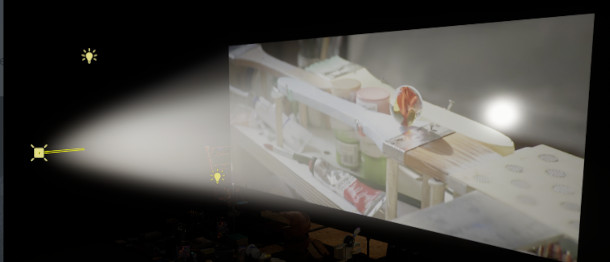Nvidia releases Omniverse Create 2022.3 in beta
Nvidia has released the first beta of Omniverse Create 2022.3, a major update to the scene layout and editing app for Omniverse, its real-time 3D design collaboration platform.
The release adds a range of new physics features to the software, including stress-based object fracturing, collision-triggered audio, and support for multiple independent physics set-ups within the same scene.
There are also updates throughout Create’s other toolsets, including to scene layout and lighting, materials, rendering and animation, and improvements to collaboration workflow and overall performance.
A USD-based collaboration platform for VFX, game development, design and visualization
Officially launched this January after a year in beta, Omniverse enables artists and designers anywhere in the world to collaborate on projects in real time.
Data is exchanged between compatible CAD and DCC applications and Omniverse in USD format, with connector plugins available for tools including 3ds Max, Maya, Revit, Rhino, SketchUp and Unreal Engine.
As well as the Omniverse core, Nvidia has released frontend applications for specific tasks, including Omniverse Create for scene layout and editing, and Omniverse View for scene review.
Omniverse Create 2022.3.0: major new physics features
The release of Omniverse Create 2022.3 coincides with Nvidia’s open-sourcing of PhysX 5, the real-time physics system that the firm describes as a “foundational technology pillar” of Omniverse.
Accordingly, physics is one of the toolsets to see the biggest changes in Omniverse Create 2022.3.0, the initial beta, ranging from usability improvements to entire new features.
In the first camp, a new Physics Authoring Toolbar provides quick access to the key tools needed to set up rigid body dynamics systems, particularly colliders.
It is also now possible to simulate multiple ‘physics worlds’ within the same scene: for example, to apply different gravity values to separate objects within a scene.
New features include Boom, a new physics-based extension for triggering sound effects when objects collide, roll or slide over one another in a scene.
In addition, the existing Blast Destruction extension now supports stress-based fracturing.

Lighting: viewport lighting presets and projector lights
The release also updates Omniverse Create’s other key toolsets, with changes to shot layout and lighting including a new quick lighting panel, for applying readymade light rigs and camera presets.
Rectangular lights get a new Projector Light Type setting, which makes it possible to use them to project a gobo texture onto objects within a scene.
Create also now supports a secondary viewport, making it possible to view a scene through two separate cameras simultaneously.
Materials: support for the MaterialX and TIFF formats
Changes to materials include support for loading and rendering materials in MaterialX format – which is becoming increasingly important in VFX pipelines – as well as Nvidia’s own MDL format.
MDL materials can also now be reloaded dynamically when an external source updates.
In addition, Create now ships with the base OmniPBR template model, for authoring custom PBR materials in the Material Editor; and now supports texture maps in TIFF format.
Rendering: adaptive sampling, AOV denoising, and initial support for DLSS 3.0
The update also brings significant changes to rendering, including support for adaptive sampling to improve path tracing performance, and the option to denoise AOVs.
In addition, on Windows, Omniverse’s RTX renderer now supports DLSS 3.0, the new render upscaling and frame generation technology rolled out alongside Nvidia’s latest Ada Lovelace GPUs.
Animation: support for motion path animation and infinite animation curves
Changes to the animation toolset include support for motion path animation, for both cameras and scene objects; and the option to loop animations infinitely.
There are also a lot of improvements to animation UX, listed in the release notes.
Improvements to collaboration workflow and overall performance
Other changes include a new layer-based system for collaboration, making it possible to set up collaboration sessions for individual USD layers within a project.
Performance has also been improved when working with large scenes, with “very dense meshes” now loading “up to 3x faster” than in the previous release.
Geometry also now loads asynchronously, with priority given to larger objects in a scene; and is suspended on running out of memory, making it possible to work on scenes that do not otherwise fit into memory.
Omniverse Create 2022.3.1: new Measure tool, plus further updates to materials and physics
A second beta release, Omniverse Create 2022.3.1, due in late November, will add a new Measure tool, shown in the video above, for making real-world measurements within a scene.
Other features due in 2022.3.1 include the option to randomise materials in a scene, to author SDF colliders for physics objects, and to adjust the centre of mass for rigid bodies visually using viewport gizmos.
The update will also further improve performance, making it possible to include “4x more” renderable instances in a scene; and will add viewport icons for other users in collaboration sessions.
Availability and system requirements
Omniverse Create 2022.3 is available in beta for Windows 10 and CentOS 7/Ubuntu 18.04 Linux. It installs from the main Omniverse launcher. It requires a Nvidia GeForce RTX 3070 GPU or better.
Ominverse is free for individual artists. For teams, commercial Enterprise subscriptions are available through Nvidia’s partner firms. You can find pricing information in this story.
See a full list of new features in Omniverse Create 2022.3 in the online release notes
